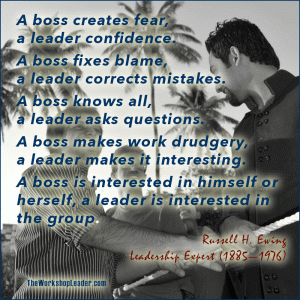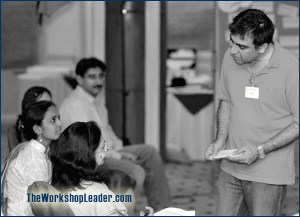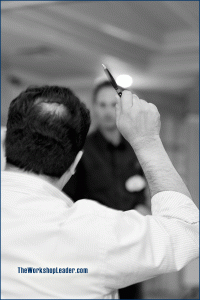A boss creates fear, a leader confidence. A boss fixes blame, a leader corrects mistakes. A boss knows all, a leader asks questions. A boss makes work drudgery, a leader makes it interesting. A boss is interested in himself or herself, a leader is interested in the group.
Russell H. Ewing (1885—1976)
British Journalist and Leadership Expert

Who asks, leads. The method of questioning is the most powerful tool in the hands of a moderator. Questioning allows you to lead the discussion in certain directions — mostly unnoticed by the audience.
Moderation can be defined as the steering of communication processes in groups. This steering happens mainly in interrogating. Therefore, it’s highly recommended to train and exercise as often as possible this basic but vital tool during group sessions.
Two types of Questions
Generally speaking we distinguish between open-ended and closed-ended questions:
- Open-ended Question: How do you see this issue? The answer can be anything and is thus open and unlimited (it can, however, be time consuming). This is crucial for discussing topics and formulating ideas, as well as in psychotherapy.
- Closed-ended Question: Can we agree on this point? Only yes or no are possible answers — or perhaps, ‘I don’t know.’This makes the discussion short.
Sorts of Questions
Closed-ended questions in particular serve the purpose of steering the discussion and in getting the answers you want. But they are also helpful for clarifications.
Reflecting / Mirroring / Rephrasing Question
Do I understand correctly that you want to have the ranking changed? You take up what someone has said, and mirror it back. That helps avoiding misunderstandings and is useful to give you time to think. This process is called paraphrasing [more see Communication/Rhetoric].
Presumptions
You say your team leader is prejudiced against you. How does that show? The participant might not have said so exactly, but you exaggerate his statement or summarise it. In response to this kind of question, he does not have time to go on that but is compelled to answer quickly.
Affirmative Question
So, this is the best solution, right? You give the impression that you are asking for consent, which is not really the case. Additionally, you keep your audience concentrated.
Deflecting Question
If you don’t agree, how would you phrase it? This places the ball in the participant’s court, which is especially helpful for challenging participants. You could also deflect to the group: ‘We have just opted for this procedure. Now you want to change it. I think this is rather frustrating. How does the group feel about it?’
Leading Question
Shouldn’t we have ice cream now? Don’t you think that this solution is the best? These questions lead to certain answers and are thus quite a manipulative way of getting an answer.
Loaded Question
Have you stopped beating your wife? While some equate leading with loaded questions, I would not do so. Loaded questions imply a controversial assumption loaded with guilt. Whatever the answer is, he admits to having a wife and admits to having beaten her at one point in time. The facts are presupposed by the question, which is not the case in leading questions. Additionally, the person can neither simply reply yes or no. Saying no means he is still beating her, even if the person has no wife or is someone who has never beaten his wife. Catch-22:You say you are crazy. But if you have enough sense to not want to fly you must be sane — and you can fly. Made famous in the novel Catch-22 by Joseph Heller (1923—1999), this is the case of creating a trick or catch question which offer no way out. Whichever way someone argues, he will have to fly.
Illusion of Alternatives
Another very manipulative form of questioning — therefore mainly used in propaganda — is the so-called Illusion of Alternatives. The enquirer offers only two alternatives from which you have to choose. Nazi Propaganda made use of this technique by giving a negative wording to the second choice: National Socialism or Bolshevik Chaos?Contemporary politicians employ this method: Either you are with us or with the terrorists. (George W. Bush). It is also deployed in religious contexts: Are you a believer or an unbeliever? In both examples, the second response has a negative connotation. You will be led to agree to the “positive” choice, but feel as if you have made the decision independently. This can lead to the performance of certain forms of action: Vote for the Nazis! Join the “War on Terrorism”! Join jihad and become a suicide bomber!
As a moderator you will be aware of this technique and you should refuse to accept this kind of question on its own terms. Life is not black and white, and there are always alternatives.
On the other hand, you can use this highly manipulative tool to steer the workshop group: Either we continue for half an hour more or you will miss out a crucial and important part without which you’ll lack the basics. What do you want?
The Art of Questioning
A lot of questions? Don’t forget: questioning is the basic craftsmanship of a moderator. The Art of Questioning is the most important toolbox for any kind of moderation — be it for group processes, in television work, on panels or in business meetings.



